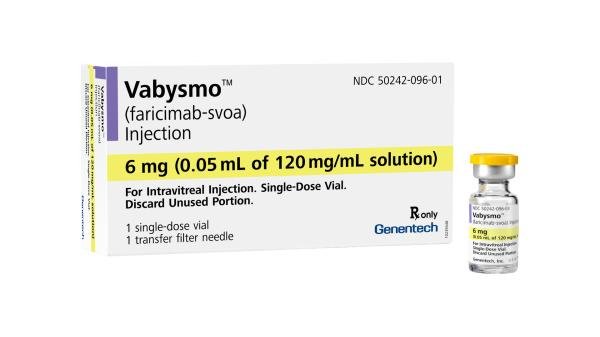Faricimab Ophthalmic Dosage
Medically reviewed by Drugs.com. Last updated on Nov 15, 2023.
Applies to the following strengths: svoa 6 mg/0.05 mL
Usual Adult Dose for:
Additional dosage information:
Usual Adult Dose for Macular Degeneration
6 mg intravitreally every 4 weeks for the first 4 doses, followed by 6 mg intravitreally on:
- Regimen 1: Weeks 28 and 44; OR
- Regimen 2: Weeks 24, 36, and 48; OR
- Regimen 3: Weeks 20, 28, 36, and 44
Comments:
- This drug should be administered every 4 weeks (about every 28 days [plus or minus 7 days], monthly) for the first 4 doses, followed by optical coherence tomography and visual acuity evaluations 8 and 12 weeks later to inform whether to administer the next dose on 1 of 3 regimens.
- Although additional efficacy was not shown in most patients when this drug was dosed every 4 weeks compared to every 8 weeks, some patients may need to be dosed every 4 weeks (monthly) after the first 4 doses.
- Patients should be assessed regularly.
Use: For the treatment of patients with neovascular (wet) age-related macular degeneration
Usual Adult Dose for Macular Edema
Regimen 1: 6 mg intravitreally every 4 weeks for at least 4 doses
- If edema is resolved after at least 4 doses (based on the central subfield thickness [CST] of the macula as measured by optical coherence tomography), then the dosing interval may be modified by extensions of up to 4-week interval increments or reductions of up to 8-week interval increments based on CST and visual acuity evaluations through week 52; OR
Regimen 2: 6 mg intravitreally every 4 weeks for the first 6 doses, followed by 6 mg intravitreally every 8 weeks (2 months) over the next 28 weeks
Comments:
- This drug should be administered every 4 weeks (about every 28 days [plus or minus 7 days], monthly) for at least 4 doses (regimen 1) or for the first 6 doses (regimen 2).
- Although additional efficacy was not shown in most patients when this drug was dosed every 4 weeks compared to every 8 weeks, some patients may need to be dosed every 4 weeks (monthly) after the first 4 doses.
- Patients should be assessed regularly.
Use: For the treatment of patients with diabetic macular edema
Renal Dose Adjustments
Mild to severe renal dysfunction (CrCl 15 to 89 mL/min/1.73 m2 [estimated normalized CrCl by Cockcroft-Gault equation]): No adjustment recommended.
CrCl less than 15 mL/min/1.73 m2: Data not available
Liver Dose Adjustments
Liver dysfunction: Data not available
Precautions
CONTRAINDICATIONS:
- Ocular or periocular infections
- Active intraocular inflammation
- Known hypersensitivity to the active component or any of the ingredients
Safety and efficacy have not been established in patients younger than 18 years.
Consult WARNINGS section for additional precautions.
Dialysis
Data not available
Other Comments
Administration advice:
- For intravitreal injection
- This drug must be administered by a qualified physician.
- Administer immediately after preparation of the dose.
- Injection Procedure:
- Must be done under aseptic conditions, which includes using surgical hand disinfection, sterile gloves, sterile drape, and sterile eyelid speculum (or equivalent), and have sterile paracentesis equipment available (if needed).
- Administer adequate anesthesia and a broad-spectrum microbicide before the injection.
- Inject slowly until the rubber stopper reaches the end of the syringe to deliver 0.05 mL; confirm delivery of the full dose by checking that the rubber stopper has reached the end of the syringe barrel.
- Immediately after intravitreal injection, monitor patients for elevation in intraocular pressure; appropriate monitoring may consist of checking for perfusion of the optic nerve head or tonometry. If required, a sterile paracentesis needle should be available.
- If the contralateral eye requires treatment, use a new syringe and change the sterile field, syringe, gloves, drapes, eyelid speculum, filter, and injection needles before administering this drug to the other eye.
- Assess patients regularly.
Storage requirements:
- Store in refrigerator between 2C to 8C (36F to 46F); do not freeze or shake.
- Keep vial in original carton to protect from light.
- Allow this drug to reach room temperature (20C to 25C [68F to 77F]) before proceeding with administration.
- Prior to use, the unopened vial may be kept at room temperature (20C to 25C [68F to 77F]) for up to 24 hours.
Reconstitution/preparation techniques:
- The manufacturer product information should be consulted.
General:
- Each vial and syringe should only be used for the treatment of a single eye.
Monitoring:
- Ocular: For elevation in intraocular pressure (immediately after injection); for perfusion of optic nerve head
Patient advice:
- After injection, immediately report any symptoms suggestive of endophthalmitis or retinal detachment (e.g., vision loss, eye pain, redness of the eye, photophobia, burring of vision); in the days after administration, seek immediate care from an ophthalmologist if the eye becomes red, sensitive to light, or painful, or if a change in vision occurs.
- Do not drive or use machinery until visual function has recovered sufficiently.
More about faricimab ophthalmic
- Compare alternatives
- Reviews (34)
- Side effects
- During pregnancy
- Drug class: anti-angiogenic ophthalmic agents
- Breastfeeding
- En español
Patient resources
Other brands
Professional resources
Other brands
Related treatment guides
Further information
Always consult your healthcare provider to ensure the information displayed on this page applies to your personal circumstances.


